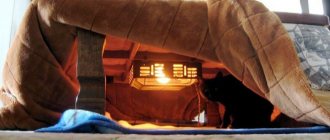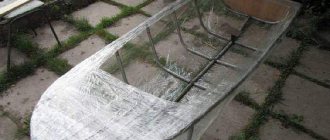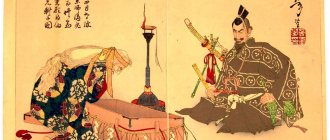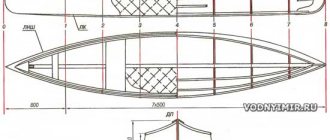And fish, and meat - and a table, and a blanket, and a hot radiator
Almost every Japanese home has a kotatsu. For residents of the Land of the Rising Sun, this is one of the most necessary things. For us, of course, this thing looks a little strange: essentially it is a table, or rather a wooden frame from it, on which a thick blanket is thrown on top, and under the tabletop there is a heater. When it’s cold, the Japanese crawl under the kotatsu, so that only their heads stick out, and warm themselves that way. Or they sit with only the lower part tucked under the blanket and go about their daily activities.
The blanket part of the kotatsu is often covered with a wooden table cover. So you can write, work on your laptop, or even eat in peace. Very convenient and practical, although what else could you expect from the inventive Japanese? But by the way, kotatsu is not a recent invention at all, but, on the contrary, a very ancient one. It has in its ancestors a traditional hearth, which is still used in provinces far from the center of civilization.
A blanket for a kotatsu is called a futon - this is a truly Japanese bedding item. In fact, it is not even a blanket, but a quilted mattress made of cotton fabric with cotton or wool filling. At night it was spread out on tatami - mats that replaced the floor covering, and in the morning it was put away in a closet. By the way, even today tourists who want to stay in traditional Japanese ryokan hotels are offered to sleep on a futon. And foreign guests are very surprised when they do not find the usual sleeping place with a bed in their rooms. The bed is prepared for them immediately before going to bed by the maids.
Use [edit]
In the twenty-first century kotatsu
usually consists of an electric heater attached to a frame, which is no longer limited to wood, but may be made of plastic or other materials.
Typically a blanket (or shitagake
) is draped over the frame and heater, as well as under the tabletop.
This first blanket is covered by a second, heavier blanket known as kotatsu-gake
(火燵掛布).
Kotatsu gake
are often decorative and can be combined with home decor.
[9] The person sits on the floor or on zabuton cushions ,
with his feet under the table and a blanket draped over his lower body.
Kotatsu
was developed when people most often wore traditional Japanese-style clothing, where heat penetrates through the bottom of the robe and rises to the neck, thus heating the entire body.
Most homes in Japan are not insulated to the same extent as those in the West and do not have central heating, so they rely primarily on space heating. Heating is expensive due to lack of insulation and drafts. Kotatsu
is a relatively inexpensive way to stay warm in the winter, like Futons Warm Air Trap.
[3] Families can concentrate their activities in this single area of the home to save on energy costs. [10] In summer, the blanket can be removed and the kotatsu
can be used as a regular table.
You can sleep under kotatsu
, although unless he is very short, his body will not be completely covered.
This is generally considered acceptable for daytime sleep, but not for nighttime sleep for many reasons: the body is not completely covered, resulting in uneven heating; The table is low, so when moving in your sleep you can accidentally touch the heating elements, which can lead to burns. Traditionally, children are told that they will catch a cold if they sleep with a kotatsu
.
However, pets such as cats often sleep under a kotatsu
, and they are small enough to fit completely underneath it—comparable to cats sleeping on underfloor heating vents in Western countries (Japanese homes typically do not have underfloor heating vents ).
Winter in Japan kotatsu
often becomes the center of home life.
In the evening, family members gather around the kotatsu
to enjoy food, television, games and conversation while keeping the lower half of their body warm.
It has been said that "once under the kotatsu
, all your worries slip away as the familiar warmth takes over and you relax completely." [eleven]
What it is?
Kotatsu is a traditional Japanese piece of furniture. This is a low table with an electric heater built into the inside of the frame, and covered with a blanket or light futon, on top of which the table top is placed. Winters in Japan are quite mild, without sudden changes in temperature, but in the off-season the houses can be quite cool, especially if we are talking about traditional Japanese houses, which have very thin walls. And since electricity is expensive in Japan, the Japanese prefer to heat themselves rather than their rooms. Therefore, on especially cold days, they gather for kotatsu. The temperature of modern heaters built into the table can be controlled using a switch, and the futon that is used to cover the kotatsu retains heat perfectly. At the kotatsu, people sit on special zabuton pillows or directly on the floor, covering their feet with a futon.
But kotatsu is not only a way to keep warm. This is a kind of family tradition that performs many communicative and educational functions. Since the Japanese spend a lot of time at work, they really value the comfort of home and their family. By gathering for kotatsu, they feel better connected with loved ones, because in this way they can not only have family dinners, but also work, study, watch TV, read or play board games. Kotatsu brings family members closer together in every sense. If a person lives alone, he can completely crawl under the kotatsu and feel protected and peaceful, as happens in childhood when we build huts for ourselves and hide in them, like in a small fortress. Pets especially love kotatsu. Cats happily climb under a table covered with a blanket and can sleep there for hours.
And although under the kotatsu they mainly warm their feet by covering them with a blanket, this is quite enough to feel warm in the cold season.
LiveInternetLiveInternet
A traditional Japanese house with its thin sliding walls and wide roof is extremely pleasant in the summer: admiring the stream in the garden, sitting in the shade and drinking green tea is much nicer. The situation is much worse in winter, because in a house made entirely of paper and well-dried wood, it is quite dangerous to light an open fire. Over time, it became possible to use central heating, but this significantly disrupted the aesthetics of the house. It would seem that you can warm up with the help of electricity, which has become a friend of people for quite a long time, but electricity in Japan is extremely expensive and is spent only on the most necessary things, and the Japanese prefer to warm up “the old fashioned way”, using the hero of our article - kotatsu
.
In relative antiquity, Japanese houses were heated by such simple means as portable braziers - hibachi
. They were filled with charcoal and placed in rooms as needed. However, “simplicity” does not always equate to “effectiveness” and it was possible to feel the warmth emanating from the hibachi only by getting as close as possible.
There was another way to heat a particular room - an open hearth, filled with clay and heated with coal, was fixed in the floor of the room. Such a hearth was called " irori"
"And in no case was it used for cooking; at most, they boiled water for tea on it.
This hearth was the progenitor of the kotatsu: a low table was placed above it, which was covered with a thick blanket like a tablecloth, and to make it convenient (and generally possible) to place dishes and other items on top of the blanket, a thick wooden board the size of the tabletop was placed. The whole family sat down at the table, put their feet under the blanket and tucked it into the lower back so that the warmth would not go anywhere. Thus, the Japanese enjoyed both physical warmth - from the brazier, and spiritual - from unity with loved ones. And if at first glance it seems that the Japanese are absorbed in work and are ready to stay there until midnight for pennies and take something else home, without seeing their wife and children and “not needing” them, then this is absolutely wrong - the Japanese are extremely attached to home and family, just according to the requirements of etiquette, they do not show it in public and do not show emotions.
Kotatsu is a kind of measure of human relationships and helps to establish mutual understanding between children and parents, especially the relationship with the father. Sitting at the same table helps smooth out awkwardness after a long separation and makes it possible to especially acutely feel unity with loved ones. Kotatsu also acts as a teacher - sitting behind him, little Japanese learn not to pull the blanket over themselves in the most literal sense of the word.
As a heater, the kotatsu seems extremely exotic and unusual for a European, because it is much more common to click on the air conditioner remote control or throw some wood into the fireplace. In Japan, electricity prices are extremely high, and winters are relatively warm, so kotatsu and heaters are quite satisfactory for the residents of the Land of the Rising Sun. In particular, the most common type of heaters are kerosene or gas, but when some of them operate, they emit a rather strong and specific smell, so the electric kotatsu, which appeared at one time, instantly became wildly popular. The heating element in this case is located under the table cover.
Japan is becoming more and more Europeanized, neighbors rarely stop by to visit each other, children leave their parents, and instead of shoji, houses are closed with full-fledged doors with locks, handles and a bell on the side. In such conditions of alienation, kotatsu seems to be something of an anchor in a haven of family peace and warm relationships in every sense.
The history of kotatsu began in the Muromachi era, in the 14th century. The original form of horigotatsu featured a wooden structure placed over an irori with smoldering coal (oki), a traditional Japanese fireplace, placed in the middle of the room, with a quilt placed on top. During the Edo era, horigotatsu was slightly modified. The floor around the irori was dug into a square shape and a wooden frame was placed on all sides. A quilt was placed on top of the tabletop mounted on the structure. A very symbolic Japanese winter scene. All family members sit around the heater with their feet under the blanket, watching TV, eating mikan (Japanese tangerines) and talking quietly. >Later, when tatami appeared in all homes, hot charcoal began to be placed in a clay pot, thus creating a portable heater, okigotatsu, which is considered almost an epoch-making event in the history of heating in Japan. After all, okigotatsu could warm each family member individually, and it did not need additional fastenings. In the mid-20th century, the heat source became electricity, the heater was built directly into the structure, and okigotatsu represented the mainstream. These days, Horigotatsu and Okigotatsu are more of a mixture, as each style has its own advantages. Horigotatsu helps you get comfortable at the table heater, and Okigotatsu is portable. And, despite the fact that the very architecture of many houses in Japan is changing, city dwellers most often do not need a kotatsu, but a traditional heater is like a nostalgic greeting from old Japan and kotatsu can often be seen in Japanese hotels. Well, probably many already know that kotatsu is a special Japanese low heated table. It's covered with a blanket on top, and there's a heating pad underneath, so when it's cold in the apartment in winter (there's no central heating system in Japan), the kotatsu just seems like paradise. It’s good to sleep there, it’s comfortable to eat there, and you can just sit and read a book. Let's try to make kotatsu in our “non-Japanese” conditions. And first of all, we need the original heating pad, which is installed below the table. The heating pad can only be ordered in Japan and costs from $80 to $200 including delivery. In addition to the heating pad, you will also need a voltage adapter 220v to 110v. The adapter can be bought on the market or in an online store. For example, Ataba company. Now you will need to reserve a table. it looks something like this: It is best to order a table made of wood. All kinds of chipboard and MDF are not suitable. If the table is ready, all that remains is to attach the device itself to it. And finally. All that remains is to order a blanket for the kotatsu and a few pillows. photo from the box Well, here it is... Finally, you can look at what I got. As you can see, the lid lifts freely and the heater located under the lid is working and ready to heat. Now all that remains is to order the blanket.
As they say, hunting is better than bondage. But when assembling this unit at home, you should be very concerned about fire safety. This especially applies to the 220\110 converter - the transformer in it can become hotter than the heater itself. And you can try to replace the original heating pad with a halogen element torn out of the UFO - a matter of technique.
You're probably wondering why I was so happy to make this article. Everything is very simple. There is an anime called The Minamike Sisters, and the scenes where the middle sister often slept with a kotatsu stuck in my memory, in general it’s a good anime, I’ll watch it someday and write a report on it. By the way, a friend of mine made a kotatsu for himself. He actually has a Japanese-style apartment. Not all, but it will be. It’s interesting that he has already made sliding doors for himself just as he wanted.
Zaisu is not just a Japanese chair
In fact, the zaisu is a completely normal Japanese chair, but only... without legs. And he doesn’t need them for the simple reason that he is designed for sitting in rooms with tatami at a very low table - kotatsu, which will be discussed below.
In order to understand why the Japanese traditionally used a chair without legs, you need to know that they used to sit either in a cross-legged position, or with one knee raised and one leg bent towards themselves, or with both legs bent under themselves - in the seiza pose , which translates to “quiet sitting.”
The national Japanese home has always been adapted for sitting on the floor on special mats - they used tatami mats and chairs only during moments of rest or eating. Sitting on a chair is also more comfortable for those who, due to old age or illness, cannot bend their legs under them. Moreover, the chair has a back that you can lean back on.
Often, when you had to sit on your knees for a long time, a special soft seat was placed under your feet - a zabuton, which is also used for zaisu. Today, a Japanese chair is almost always equipped with a soft seat, which can be removable. For convenience, armrests called kyosoku are also added to the chair.
Today, when the Japanese style has become quite popular in Europe, in many European houses you can find tatami rooms equipped with traditional Japanese furniture - including zaisu chairs, of which there are now a great variety of different models.
Traditional heating device - heated table
Kotatsu is a heating device that has been used in Japan since ancient times. It consists of a low table covered with a blanket, under which there is a heat source. In the old days they used a brazier with coals, but now there is usually an electric heater under the table cover. It is often mentioned in Kawabata Yasunari's novel The Land of Snow. Sometimes, for convenience, a recess is made under the kotatsu into which the legs are lowered; This variety is called horigotatsu - “kotatsu with a notch.” A kotatsu without a notch is okigotatsu, “a placed (portable) kotatsu.” Recently, there are also high tables for chairs of the Western type, equipped with a heater - dainingu-kotatsu, “dining kotatsu”, by analogy with a dining table.
Cat warming itself under a kotatsu
In the absence of other heating devices that would provide constant heat, kotatsu is still constantly used in many homes. In winter, the whole family settles down at the kotatsu, talks, eats, watches TV, and naturally most of the family communication takes place at the kotatsu.
Kotatsu family watching TV
Design and use of a heated table
Since the most common type of kotatsu is electric, we will consider it. Externally, the table looks usual: a square or rectangular (less often round) tabletop on low legs (about 40 cm). To Europeans, this piece of furniture most closely resembles a coffee table. The main highlight of the kotatsu is the inside of the table top, which has a mount for an electric heater. Since heating tables are widely used in Japan, the slots for the heaters are of standard sizes. Accordingly, you can also purchase a heater separately; there are plenty of varieties.
For our country this is exotic, but still some users appreciated the convenience and cost-effectiveness of the device. Kotatsu is often made by hand. The main difficulty is choosing a suitable heater. And here a thermal cassette with an IR heater is perfect, which just needs to be secured under the countertop. Kotatsu is used in the same way as centuries ago. A futon is thrown over the table like a tablecloth, which can easily be replaced with a rug or blanket, and an additional tabletop is placed on top of it. Usually all family members gather at the table and hide their legs under the futon, tucking it into the lower back. The heat that the lower body receives is enough to keep you completely warm.
In Japanese families, the kotatsu is the center of life. They work, study, eat, communicate, play board games, read and watch TV. At the same time, you can not only sit, but also lie or recline, minding your own business and warming your feet.
Sometimes kotatsu is used for sleeping if the days are particularly cold. In this case, the lower half of the body remains under the table. Even in a completely unheated room with single windows and walls 10 cm thick, it is quite comfortable and warm to be there.
Secrets of Kotatsu
A Russian will definitely ask: isn’t it cold to just sit under a blanket if the house isn’t heated? The fact is that in Japan, in most regions, winters are quite mild; there are no severe frosts here. So the kotatsu protects itself from the cold quite well. And besides, this is the most comfortable place in the house, which brings the whole family together, because it is impossible to swear or sulk at each other when you are all lying under the same table.
Kotatsu are different. There are round and square tabletops, larger and smaller ones, with an electric or coal heater. But still, this thing is present in almost every home: both because it is convenient and because it is economical - it is much cheaper to use than any other types of heating devices. Kotatsu “live” in families for many years; during the summer they are moved away, and with the onset of cold weather they are brought out again.
And the Japanese are real cat fans. And, of course, those who have these pets at home cannot allow them to freeze. That’s why they put on a kotatsu: so that the beloved pet can blissfully warm its sides under a warm blanket, lying next to its owner.
History[edit]
History of kotatsu
begins during the Muromachi period or Ashikaga shogunate in the fourteenth century.
[2] [3] Its origins begin with the Japanese culinary hearth known as irori
.
Charcoal was the main method of cooking and heating in the traditional Japanese home and was used to heat irori
.
[2] By the fourteenth century in Japan, irori
had introduced a
seating platform,
and the cooking function became separate from the seating function.
A patchwork quilt known as an oki was placed on top of the wooden platform.
this captured and localized the heat from the coal burner.
[4] [5] This early ancestor of the modern kotatsu
was called
hori-gotatsu
.
The word hori-gotatsu
(
掘
り炬燵) comes from the character 掘り(hori) meaning ditch, digging, 炬(ko) meaning torch or fire, and 燵(tatsu) meaning foot warmer. [2] [6]
Formation of Hori-gotatsu
changed somewhat during the Edo period in the seventeenth century.
These changes consisted of the floor around the irori
being
dug
into the ground in a square shape. A wooden platform was placed around it, making a hearth. The blanket is then placed back on the platform so you can sit down with your feet under it to keep warm. [2]
Movable kotatsu
was created later,
based
on the concept of
hori-gotatsu
.
This kotatsu
comes from the popular use of
tatami mats
in Japanese homes.
Instead of placing
the coals in
an irori
, they were placed in a clay pot which was placed on
a tatami,
making
the kotatsu mobile
.
[2] This more modern style of kotatsu
is known as
oki-gotatsu
.
The word oki-gotatsu
(置き炬燵) comes from the kanji 置き(oki) meaning placement, 炬 meaning torch or fire, and 燵 meaning foot warmer. [7]
In the mid-twentieth century, charcoal was replaced by electricity as a heat source. Instead of placing a mobile clay pot with coals under the kotatsu
, it was possible to attach an electric heating device directly to the
kotatsu
.
By 1997, the majority (about two-thirds) of Japanese homes had modern irori
and 81% had
kotatsu
, although they are heated with electricity rather than hot coal or charcoal.
Thus, the kotatsu
became completely mobile thanks to electricity and became a common sight in Japanese homes during the winter. [2] [8]
How to use kotatsu
To keep warm, the Japanese sit around the kotatsu on special pillows called “zabuton” - you can completely cover yourself with a futon or wrap only your legs. The blanket insulates a small amount of heated air, which is not circulated throughout the house, but is used only for the comfort of the human body.
Reference! As the Japanese themselves say, their unique invention helps you feel comfortable even in a room that is completely unheated. This is quite beneficial, since the kotatsu itself does not require significant electricity costs.
Varieties of kotatsu
Naturally, everyone improved a popular thing in their own way. This is how several varieties of kotatsu appeared:
- Okigotatsu is another name for traditional portable katatsu without a notch;
- horigotatsu - a table with a recess into which the legs are lowered;
- dainingu-kotatsu - a European version with high legs for the use of chairs, can be translated as dining kotatsu.
These tables are so popular that they even led to the emergence of new words in the Japanese language. For example, “kotatsumuri” (muri from Japanese - snail) is a person who is accustomed to kotatsu, like a snail to its house. Kotatsumuri is a humorous name for people who spend all their free time in front of the kotatsu and only go to the toilet.
Other countries
Similar systems exist in many countries around the world: economical and often sociable ways to stay warm while sitting still. In Spain and Portugal, Camilla mesa [ES]
is a small round table with
a brasero
heater (i.e. brazier) placed underneath it. In the Netherlands, a footslab was previously used. During World War I, British Royal Engineers built "Japanese hot water bottles" in the trenches.
Tajikistan and Afghanistan have very similar sandals
, which even today are used in many traditional homes as a
cozy family dining area
.
Another similar item called korsi
is also used in Iran.
In China and Korea, heated floors are traditionally used. Devices used in this manner are the Kan and Ondol
.
Types
There are two main types of kotatsu currently used in Japan, which differ in the heat source:
- Electric
is a more modern type of kotatsu that involves a table with an electric heater attached to the underside of the table. This kotatsu is usually placed on a thin futon. A second, thinner futon is used to cover the table, and a tabletop is placed on top. - Coal
is the traditional type, which is installed in a special niche approximately 40 centimeters deep, in the floor or walls of which an electric or coal heater is placed. The heater can also be attached to the table, as in modern kotatsus.
However, anything can serve as a heat source: from Yutampo water heating pads to heated stones placed in a special box.[1]
How to make a kotatsu with your own hands - support system
In order to assemble such a table yourself, you will need a tabletop, as well as wooden slats. The height of the bars for the legs should be half a meter, the cross-section of this rail should be a square with a side of 8 centimeters. The planks connecting the legs together should be 84 centimeters in length, their cross-section should be a rectangle with dimensions of 4 by 10 centimeters. The side strips and legs are connected using choppers. You must first drill a hole for these wooden fasteners using a drill. You need to make 3 holes on each side. As a result, to create a structure of legs and side slats, you will need 24 chops.
To make the support system stronger, it can be supplemented with metal corners, fixed at right angles in the area between the leg and the bar on both sides. Although such an addition is not necessary.
Tatsuhiko Takimoto - Welcome to NHK!
1 …
Welcome to NHK!
Tatsuhiko Takimoto
Prologue
There are conspiracies in this world.
However, there is a ninety-nine percent chance that the plausible conspiracy stories you hear from other people are simply misconceptions or even deliberate lies. If you go to a bookstore, you will see books with titles like “The Great Jewish Conspiracy Destroys the Japanese Economy!” or “Super Conspiracy: The CIA is Hiding a Secret Treaty with Aliens!”, which are mere fictions.
Despite this... People love conspiracies.
Conspiracies. We are hopelessly enchanted by the bittersweet sound of this word.
Consider, for example, the emergence of the “Jewish Conspiracy” theory. The author is haunted by terrible complexes and experiences, for example: “Why am I poor?”, “Why do I live so poorly?”, “Why can’t I find a girlfriend?” There is constant pressure on his mind and body from both outside and inside.
This hidden discontent turns into a feeling of endless hatred towards society. It becomes anger.
However, the main source of this anger is his own cowardice.
He is poor because he lacks the skills to earn money. He doesn't have a girlfriend because he lacks charm. But it takes a lot of courage to see the truth and admit your imperfections. No person, no matter who he is, wants to look directly at his shortcomings.
Therefore, the author of the conspiracy theory looks externally for the reasons for his cowardice.
He creates a fictitious "enemy" outside of his inner world.
Enemy. My enemy. Public enemy.
“I cannot be happy because of the conspiracy of evil enemies. Because of this conspiracy, I cannot find the girl. Exactly! The Jews are to blame for everything. I cannot be happy because of the intrigues of the Jews. Damn Jews! I won't forgive you!
In truth, similar thoughts sometimes occur to Jews too.
Anyone who builds conspiracy theories should take a closer look at reality.
“Enemies” do not exist outside. "Evil" does not exist outside. Only you yourself are to blame for being a nonentity.
This is not a Jewish conspiracy, it is not a CIA conspiracy, and, as obvious as it may be, it is not an alien conspiracy. Everyone should remember this.
But still…
A tiny percentage of people become victims of a real conspiracy. There is one person who witnessed a conspiracy that is still operating in the strictest secrecy.
Who is this man?
It's me.
Chapter 1: Birth of a Fighter
Part one
One cold January night, I learned of the existence of a conspiracy.
In my tiny one-room apartment with six tatami mats[1], I tried to warm up while sitting at the kotatsu[2]. It was a terribly dreary night.
Despite the advent of the new millennium, there was no hope on the horizon. I even burst into tears while eating my New Year's soup[3].
For an unemployed twenty-two-year-old college dropout, the winter cold was piercingly cold. Sitting in the middle of my dirty room, where the floor was littered with scattered clothes and tobacco smoke saturated the walls, I sighed again and again.
How could it come to this?
That was all I could think about.
“Oh,” I groaned.
If I don’t correct my situation soon, I will completely sink and be lost to society forever. Moreover, I had already been expelled from college. I needed to quickly find a job and get back to normal life.
But I... just couldn't do it.
Why? What was stopping me?
The answer is simple - because I am a hikikomori[4].
The most relevant and popular social phenomenon of our days is hikikomori. It's me. Recluse.
It is said that there are now about two million hikikomori living in Japan. Two million is a huge number. If someone threw a stone on the street, it would hit a hikikomori... Of course, in reality this would not happen. Hikikomori don't go outside.
Anyway, I was one of those hikikomori that are so common in Japan. Not to mention that I was something of a veteran hikikomori. I only left my apartment once a week to go to a 24-hour supermarket for food and cigarettes. I had zero friends, and I slept sixteen hours a day.
This year marks four years since I became a hikikomori. Because of my lifestyle, I was kicked out of college.
True, I was such a disgusting hikikomori that I should have been given the title of professional. No matter who I was compared to, I would hardly lose easily to another hikikomori.
In fact, I was sure that if there was a “Hikikomori International Olympics”, I would do well in it. I thought that I could defeat any other hikikomori, no matter what country he was from: a Russian hikikomori who escapes reality with the help of vodka, an English hikikomori who finds salvation in drugs, or an American hikikomori who shoots at everything at home with a pistol.
Exactly! The famous founder of the Kyokushin style of karate[5], Masutatsu Oyama, also known as "The Divine Hand", supposedly spent his entire youth in the mountains in solitude, strengthening his spirit, before becoming the world's greatest karate master. If you look at it from this point of view, after sitting in this apartment for many years, I must be very close to becoming the strongest person in the world.
Well, it's worth a try. I decided to take a beer bottle and try to break it with the edge of my palm.
- Kiiiiii!!!
***
Bandaging my bloody hand, I sat down at the kotatsu again.
Anyway, my brain hasn't been working the way it's supposed to lately. Maybe it was because I slept sixteen hours a day? Or because I avoided contact with other people for more than six months?
All day my mind was clouded. I even felt unsteady when I went to the bathroom.
But I didn't care at all.
The more important issue was to end this miserable hikikomori lifestyle.
Exactly! I must end this rotten life of a hikikomori as soon as possible. Return to human society! Recover after expulsion! I will work, find myself a girlfriend and lead a normal life!
1 …











